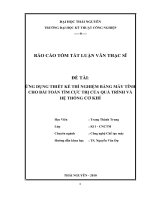kỹ thuật điện hệ điều hành thí nghiệm 5 sinhvienzone com
Bạn đang xem bản rút gọn của tài liệu. Xem và tải ngay bản đầy đủ của tài liệu tại đây (111.13 KB, 3 trang )
Lab 5 – Semaphore &
Shared memory programming
Notice:
Submitted file name: lab5.tar.bz2
Student can modify source code
All cheats will get ZERO if detected
1
Introduction
1.1 Goal
Writing a C program to calculate sum of prime numbers of integers using semaphore and shared memory
techniques.
1.2 Prerequisite
C programming
Multi-process programming
Semaphore programming
Shared memory programming
Makefile
1.3 Description
Input:
Integer numbers
Output:
Sum of prime numbers of those integer numbers
Implement the above program by using shared memory to share their result and using semaphore to solve
conflict problem when these processes read from or write to shared memory at the same time.
1.4 Implementation guide
When running, program will using fork function to duplicate to 2 processes: parent process and child
process.
These two processes works as work pool model (as illustrated in the following figure)
100
57
P0
2 100
14
20
P1
96
SinhVienZone.com
/>
Integer numbers on the command line are stored in an array.
These two processes use shared memory to share their data. The shared memory segment includes 2
integer number, the first one denotes the next available element index of array, the second one denotes
sum of prime numbers of all previous integers.
Before getting an elemet in array to process, process reads the first number in shared memory to get
the element index. After reading that element, that process increases the index by 1 and writes the new
value to shared memory, index of array is increased by 1.
After that, the process calculates sum of prime numbers of the element it has read, then it accumulates
to the total sum (by reading the second number in shared memory), then it writes the new total sum
into shared memory.
After processing all elements of input array, process that processes the last element prints out the
result of input numbers.
To prevent inconsistent result of reading and writing between these two processes, we use a
semaphore to synchronize these processes.
1.5 Programming techniques
1.5.1
Parsing command line's arguments
A command line may have some arguments, in the program we can get these ones by using argc & argv
arguments of function main.
int main(int argc, char* argv[])
With the above declaration, argc counts number of arguments we pass to the command line (including
executable file name), and argv contains strings corresponding to those arguments in the order.
For example, when we execute command:
sum 2 5 7 9
to calculate all numbers we pass as arguments, the above command will result in argc=5, and
argv={“sum”,”2”,”5”,”7”,”9”}.
1.5.2
Using shared memory
Referring to lab slides.
1.5.3
Using semaphore
Referring to lab slides.
2 Requirements
Program syntax:
sumprime [positive integer number]+
SinhVienZone.com
/>
Arguments of the program are positive integer numbers, the number of arguments must be greater than or
equal to 1.
The result of the above program is printed on the screen.
3 Examples
$ ./sumprime 3
3
$ ./sumprime 6
5
$ ./sumprime 8
6
$ ./sumprime 3 6 8
14
SinhVienZone.com
/>









